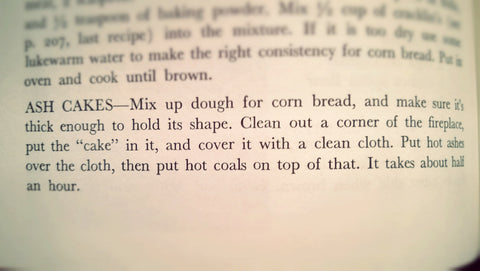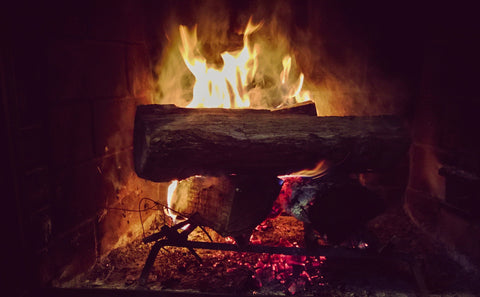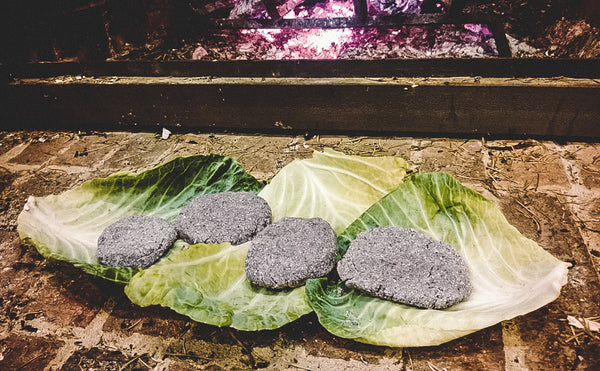How to Make Blue Corn Ash Pone
Feb 12, 2014
I have been interested in this stuff called “pone” since I first read about it in Book 4 of the great Foxfire series. Here in the south you may hear references to it called Corn Pone or Hoe Cakes. It is an old food used by the poorest folks, made simply of coarse corn grain, water, and salt. Some variations use baking powder and others will add in flour as well. At that point you are getting close to a cornbread recipe.
Traditionally white corn was used because that is what they had, but I really like the taste of blue corn and decided to use that instead. On a side note, my family loves to eat Amish blue popcorn — it’s pretty great stuff!
Ash Pone
Ash pone is corn pone cooked in the coals of a hearth or other open fire. The ashes get on the pone and it is just dusted off before eating.
A Little History
Here is the deal, this stuff doesn’t taste great. Throw some molasses, honey, or jam on there and it’s pretty good. What is neat about these old recipes is that you get a chance to experience what was a common meal of Confederate soldiers, mountain folk, and poor rural people. You also get to connect with hearth cooking. It’s tough and will make you appreciate an oven. However, it’s also fun and the whole family can get involved.
Here is a snippet that talks about making Ash Pone (called Ash Cakes here) from the Foxfire Book 1.

Description of how to make Ash Cake (Ash Pone) from Foxfire Book 1
Here’s a quote from Foxfire Book 4, where I first heard the term ash pone and ash cake.
“The real poor people that I can remember used ash cakes. Now that’s maybe something you don’t know. If you happen to have a hearth, you rake your fire coals or your ashes out on it. If you have your dough ready, you laid it down on that and you covered that with coals or ashes. When that got done, you’d take it up and shake the ashes off and eat it; and that’s the fun that the old poor men like my dad got to do.” – Charlie Ross Hartley, Foxfire Book 4
Wood Ash and Health
As a side benefit, there are studies taking place that talk about the health benefits of ash. Ash has a high calcium content and it may aid in digestion as well as flavor. Ashes are completely safe to eat due to them being disinfected through fire, however, they don’t taste great in too large of a quantity so be sure to dust off the pones once they are cooked.
The Basic Recipe
- 3 cups of corn meal
- 2 cups of boiling water
- Salt to taste
- Hard wood for the fireplace (Oak, Cherry, Hickory etc. Pine and other soft woods are high in resin and can spoil the taste of the food.)
- (0ptional) Cabbage leaves, corn husks, or a cloth for covering the pones
Making Ash Pone
Step 1 – Get the fire going
What is really needed for hearth cooking are white hot coals. This takes about an hour to produce so begin this step first.

Step 1: Get a fire going
Step 2 – Boil water and mix with corn meal and salt
Stir the water in with the corn meal and salt and let sit for a few minutes (because it will be hot!). The resulting mix should be similar to a dough which can be formed.

Corn Pone mixture after sitting for a few minutes
Step 3 – Form the pones
Shape the pones into discs or oval shapes. The thinner they are the faster they will cook.

Traditionally pones were formed into an oval shape
Step 4 – Lay the pones on the cabbage leaves or back of hearth and cover with ashes
Once a few logs have burned to white hot coals, rake a few onto the hearth and place the cabbage leaves on top. Put the corn pones on top and then another layer of cabbage leaves. Top it off with a lot of coals.
You need to keep the fire going and add new coals ever so often if using this method.
Note: A better option is to do the same steps above inside the hearth. I found that it takes quite a while and a good deal of heat to really get the pones toasty and cooked on the inside. The only trouble is the heat. You need a good, long set of hearth tools such as a shovel and tongs to work with.

Corn pones on cabbage leaves. Other green leaves or corn husks can be used as well.

Ashes on cabbage leaves and directly on corn pones
Step 5 – Enjoy!
After about an hour the pones should be done. Remove from the coals and brush the ashes off.
Pones are fairly bland by themselves so have some syrup, honey, butter, and\or jam ready. Tell the kids about this being breakfast for many people and often the only kind of sustenance soldiers could get on the weary road to battle. Somehow, thinking on those things makes it taste alright.



